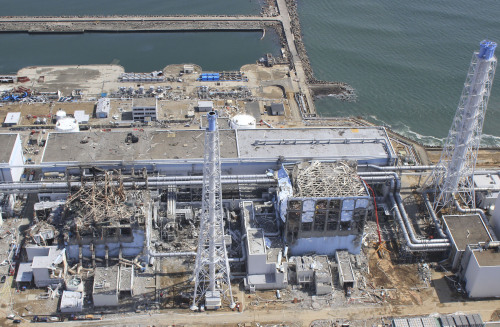 |
An aerial view of the Fukushima Daiichi Nuclear Power Station is seen in Fukushima Prefecture in this photo taken by Air Photo Service on March 24.(AP-Yonhap) |
SENDAI, Japan (AFP) ― Japan was Wednesday considering plans to drape shattered nuclear reactor buildings with special covers to limit radiation, and pump contaminated water into a tanker.
The embattled nation, reeling from the triple calamity of a massive earthquake, tsunami and a crippled atomic power plant, was also inviting foreign experts to help stabilize the overheating Fukushima station.
The United States has lent Japan robots of a model battle-tested in Iraq and Afghanistan that can crawl through, film and clear rubble in the blast-hit reactor buildings which humans can’t enter because of very high radiation.
And France, which relies on nuclear power for three-quarters of its domestic energy needs, was sending an expert team from Areva, its state-run reactor maker, to assist embattled operator Tokyo Electric Power Co.
The strain of the crisis appeared to have taken a toll on TEPCO’s president Masataka Shimizu, 66, who was hospitalized Tuesday evening with high blood pressure and dizziness, having not appeared in public for over two weeks.
The company has seen its share price plunge by three-quarters and faced heavy criticism, most recently over news that it ignored expert warnings on the threat of a tsunami before a giant wave crashed into the plant on March 11.
As Japan works to contain the world’s worst nuclear disaster since Chernobyl in 1986, an official with the nuclear safety agency said Wednesday it was time to think outside the box.
“We are in an unprecedented situation, so we need to think about different strategies, beyond what we normally think about,” the official said.
Japan faces a dilemma in containing the nuclear crisis: it must pump water into reactors to stop them from overheating, even as highly radioactive runoff leaks out, halting crucial repair work and threatening the environment.
 |
A consumer shops for seaweed, thought to protect against radiation poisoning, in Seoul on Wednesday after radioactive traces from a stricken Japanese nuclear plant were detected here. (Related story on Page 6) (Park Hae-mook/The Korea Herald) |
Iodine-131 detected in Pacific Ocean water near the plant site surged to a new high of 3,355 times the legal limit, officials said ― compared to the previous top level of 1,850 times the legal maximum taken days ago.
“The figures are rising further,” said nuclear safety agency spokesman Hidehiko Nishiyama. “We need to find out as quickly as possible the cause and stop them from rising any higher.”
Radioactive steam has also wafted into the air, contaminating regional farm and dairy produce, and last week led to elevated iodine levels in drinking water in megacity Tokyo, 250 kilometers to the southwest.
Japanese authorities have repeatedly stressed that none of the affected food products or water currently presents an immediate threat to human health, and that ocean currents will dilute radioactivity in the sea.
Among the options Japan’s government is now considering is covering three badly damaged outer reactor buildings with special fabric caps and fitting air filters to limit radiation, the Asahi Shimbun reported.
Another plan is to anchor an empty tanker off reactor two, so that workers can pump several Olympic swimming pools worth of highly-radioactive runoff water into its hull, the daily said, citing unnamed government officials.
While the government did not explicitly confirm the report, Chief Cabinet Secretary Yukio Edano said Japan’s leadership and nuclear experts were discussing “every possibility, including those mentioned in the press.”
With crucial control room functions still disabled, experts are not sure what exactly is happening inside the reactors ― and some international experts have issued dire warnings that a meltdown may already be in progress.
One of them is Richard Lahey, who was head of safety research for boiling-water reactors at General Electric when it installed the Fukushima units, and who was quoted by Britain’s Guardian newspaper.
Available reactor and radiation data from the especially troubled unit two “suggest that the core has melted through the bottom of the pressure vessel” and onto the concrete floor, he was quoted as saying by the daily. “I hope I am wrong, but that is certainly what the evidence is pointing towards.”
In Washington, acting U.S. assistant secretary in the Department of Energy’s Office of Nuclear Energy, Peter Lyons, told senators Tuesday that “current information suggests that the plants are in a slow recovery.”
“However, long-term cooling of the reactors and pools is essential during this period and has not been adequately restored to date, to the best of my knowledge. A massive cleanup operation obviously remains for the future.”
Tokyo plans to scrap Fukushima's four cripped reactors
Tokyo Electric Power Co. revealed its plan Wednesday to scrap the four crippled reactors at the Fukushima Daiichi nuclear power plant as the country struggles to bring the nuclear crisis under control weeks after a powerful earthquake and tsunami, according to Kyodo News.
"The utility said that while the cost of compensation in connection with the nuclear disaster will be daunting and will undermine it financially, the company will try hard to remain afloat and avoid nationalization," the report said.
''We have no choice but to scrap reactors 1 to 4 if we look at their conditions objectively,'' said Tsunehisa Katsumata, the company's chairman, at a news conference, according to Kyodo.
Since losing cooling functions following the deadly natural disaster on March 11, four of the six reactors at the nuclear power plant northeast of Tokyo have leaked radioactive materials into the air and sea.
While workers are continuing efforts to prevent the reactors from overheating and restore their cooling systems, all six reactors at the plant have been stabilized to some degree, Katsumata reportedly said.
도쿄전력 회장 "원전 1∼4호기 폐쇄하겠다"(종합) (도쿄=연합뉴스) 도쿄전력의 가쓰마타 쓰네히사 회장은 30일 방사성 물질 유출 사고를 낸 후쿠시마(福島) 제1원자력발전소 1∼4호기를 폐쇄하겠 다는 입장을 밝혔다.
가스마타 회장은 이날 오후 기자회견에서 "후쿠시마 제1원전 1∼4호기의 상황을 객관적으로 볼 때 폐쇄하지 않을 수 없다"고 말했다.
원전 사고를 낸데 대해서는 "건물의 폭발과 방사성 물질의 유출 등으로 여러분 에게 불안과 심려, 걱정을 끼친데 대해 사죄한다"고 말했다.
이날 병원에 긴급 입원한 시미즈 마사타카(淸水正孝) 사장에 대해서는 "입원 기 간이 오래 걸리지 않을 것이며 곧 복귀해 경영을 지휘할 것이다"고 밝혔다.
그는 또 후쿠시마 원전 사고에 따른 재정적 타격이 어느 정도인지는 아직 집계 되지 않고 있으나 "매우 심각할 것"으로 보인다고 밝혔다.
그는 주요 은행들로부터 확보한 2조엔(240억 달러)의 긴급 대출금은 원전 사고 로 인해 소요되는 비용을 충당하기 충분하지 않다면서 정부와 충분한 자금 확보 방안에 대해 논의할 계획이라고 밝혔다.
가스마타 회장은 또 도쿄전력 국유화 검토설과 관련, "도쿄전력이 민간기업으로 남아있을 수 있도록 최선을 다할 것"이라고 말했다.
지난 12일 후쿠시마 원전 사고가 발생한 이후 가쓰마타 회장이 회견에 응한 것 은 이번이 처음이다.








![[Today’s K-pop] Blackpink’s Jennie, Lisa invited to Coachella as solo acts](http://res.heraldm.com/phpwas/restmb_idxmake.php?idx=644&simg=/content/image/2024/11/21/20241121050099_0.jpg)
